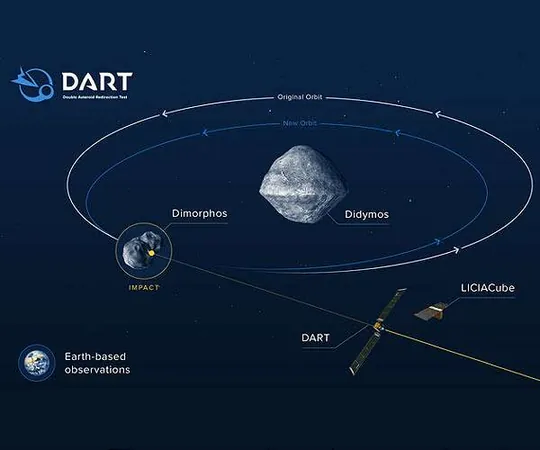
Astronomers Uncover Unexpected Source of Potentially Dangerous Asteroid
2025-04-13
Author: Rajesh
A Shocking Discovery in Space!
In an astonishing revelation, astronomers at the W. M. Keck Observatory in Hawaii have traced the origin of the recently discovered Earth-crossing asteroid, 2024 YR4, to a surprising source. This rocky behemoth, unearthed in December 2024, is believed to have originated from a central Main Belt asteroid family nestled between Mars and Jupiter—a region not typically linked to Earth-threatening asteroids.
Meet YR4: The Asteroid with a Distinct Character
The asteroid spins ominously every 20 minutes in a retrograde direction, flaunting a unique, irregular shape with a density akin to solid rock. According to Bryce Bolin, the lead researcher, this physical structure offers vital insights into how YR4 formed and its potential risks to Earth. "Understanding these properties is crucial for determining how to mitigate its threat if necessary," Bolin stated.
Potential Impact? Not Quite!
Initial models alarmingly suggested a possible collision with Earth in 2032; however, follow-up analyses have alleviated those fears. Yet there's still a slight concern—a 2% chance that YR4 may collide with the Moon. Bolin elaborated, "At approximately 50-60 meters wide, YR4 is one of the largest objects capable of striking the Moon in recent history. Such an event would offer us a rare opportunity to study the relationship between asteroid size and crater formation like never before!"
The Mystery of YR4's Composition
Unlike larger asteroids often made up of loose debris from past collisions, YR4 seems to be a solid remnant, possibly a boulder from a much larger celestial body. The team also investigated how the Yarkovsky Effect—an effect caused by sunlight—affects asteroids' orbits. YR4's low thermal inertia hints that it is likely a monolithic rock, contrasting sharply with the more chaotic rubble piles typical of larger asteroids.
Precision Observations Brought Success
Employing infrared observations with the Keck Observatory's Multi-Object Spectrograph for Infrared Exploration (MOSFIRE), Bolin’s team was able to determine YR4's physical characteristics with impressive accuracy. This meticulous data gathering was further enhanced by contributions from systems like the Asteroid Terrestrial-impact Last Alert System (ATLAS) and the Gemini South telescope in Chile.
A Stroke of Luck for the Researchers
Originally set to study distant objects beyond Neptune, Bolin and his team found themselves pivoting due to technical issues, ultimately capturing invaluable data on YR4. This newfound knowledge will be pivotal for refining rapid asteroid characterization techniques, essential for assessing potential threats.
A Glimpse into the Future of Planetary Defense
The insights gained from this study not only enhance our understanding of 2024 YR4 but also set the stage for future asteroid defense strategies. As Bolin aptly put it, "The physical details—be it a rubble pile or solid rock—are vital for planning our planet's defense should we ever face a significant threat from space."
Conclusion: A New Chapter in Astronomical Research!
The saga of 2024 YR4 is a testament to the astounding discoveries that continuously reshape our understanding of the cosmos. As scientists sharpen their tools for rapid observation and analysis, we inch closer to mastering the art of asteroid risk assessment—ensuring our planet remains safe from the silent but deadly threats lurking in the void.



 Brasil (PT)
Brasil (PT)
 Canada (EN)
Canada (EN)
 Chile (ES)
Chile (ES)
 Česko (CS)
Česko (CS)
 대한민국 (KO)
대한민국 (KO)
 España (ES)
España (ES)
 France (FR)
France (FR)
 Hong Kong (EN)
Hong Kong (EN)
 Italia (IT)
Italia (IT)
 日本 (JA)
日本 (JA)
 Magyarország (HU)
Magyarország (HU)
 Norge (NO)
Norge (NO)
 Polska (PL)
Polska (PL)
 Schweiz (DE)
Schweiz (DE)
 Singapore (EN)
Singapore (EN)
 Sverige (SV)
Sverige (SV)
 Suomi (FI)
Suomi (FI)
 Türkiye (TR)
Türkiye (TR)
 الإمارات العربية المتحدة (AR)
الإمارات العربية المتحدة (AR)